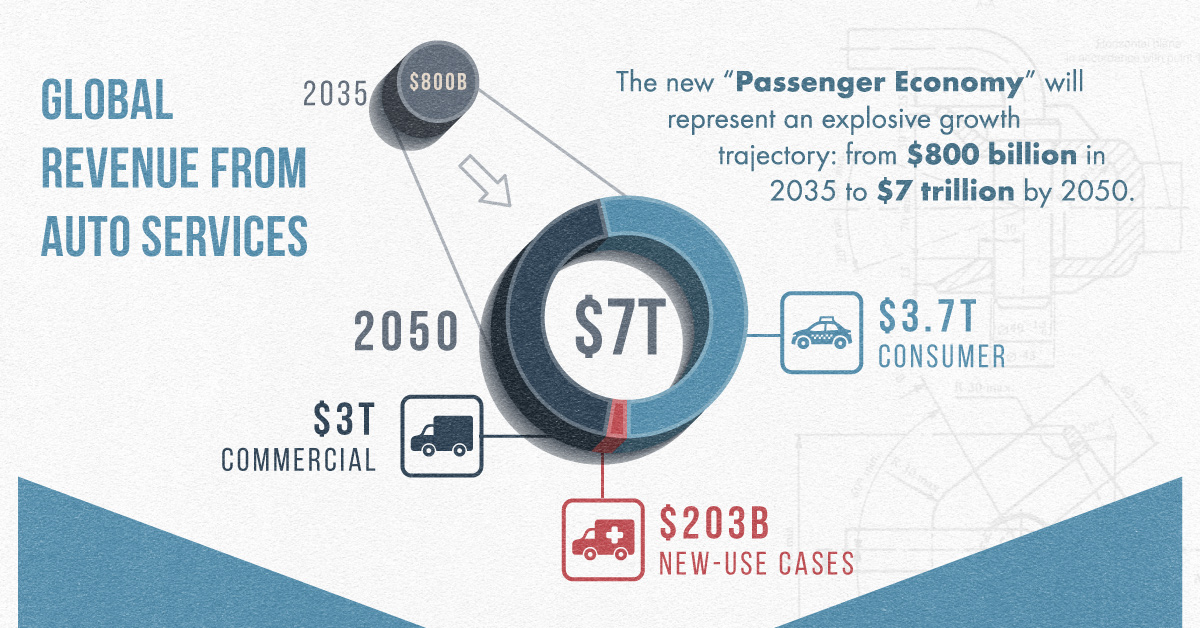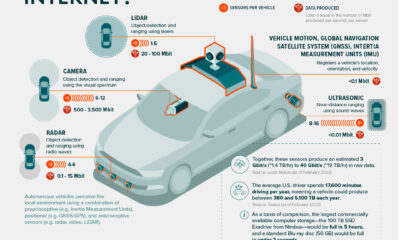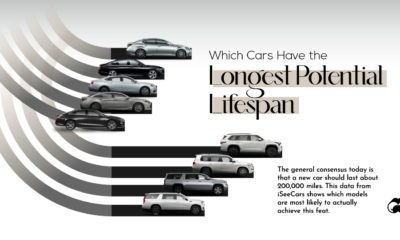Manufacturers created new body styles and market segments, automatic transmissions and power steering were introduced, and safety features such as airbags made passengers much safer. Computers were even added into cars to optimize performance and provide GPS for navigation purposes.
In short, vehicles got cheaper, lighter, stronger, safer, cleaner, faster, and more luxurious.
But despite this, there is a strong case that the biggest innovations in the auto industry are yet to come.
A New Era of Automotive Innovation
Today’s infographic comes to us from Evolve ETFs and it explains the many forces shaping the future of automotive innovation. Unlike past periods of innovation in the industry, the coming years will be particularly interesting because many of the changes will come from outside of the traditional workings of a car. Automation and the shared economy will change how the entire commuting model works. Meanwhile, an increased penetration of EVs will have an impact well beyond the engine, as charging infrastructure needs to be added, battery supply chains need to be created, and as legacy auto parts become obsolete. While these transitional changes take place, the auto market is expected to jump from $3.5 trillion (2015) to $6.7 trillion (2030) in total size – and a whopping 30% of the revenue will come from new services that don’t even exist today.
The ACES Framework
The future of automotive innovation will hinge on four major technologies: automation, connectivity, electric power, and the shared economy. This can be simplified into the acronym “ACES”: A: Automation Perhaps the most obvious and fundamental change facing the auto sector is the rise of autonomous cars. Not only does this technology have implications on major manufacturers and suppliers to the auto sector, but giving the cars the ability to self-drive will have an impact that extends well beyond it, as well. The passenger economy, which will come from relieving people from the driver’s seat, is expected to be a $7 trillion industry alone by 2050. C: Connected New cars are already taking advantage of increased connectivity today, and it will soon be the norm even in lower-end vehicles. This added networking unlocks new features such as infotainment, enhanced safety features, and diagnostics and analytical tools. E: Electric In just seven years since its IPO, Tesla was able to leapfrog Ford in market valuation. Yet, this is still the very beginning of the EV revolution. Many countries have announced regulations to curb gas or diesel fueled vehicles, and EVs are expected to hit 41 million global sales by 2040. S: Shared The shared economy is the result of technological factors, but also societal ones. However, when combined with automation, sharing presents a fundamental shift to how commuting and transportation will work in the future. With autonomous and shared cars, current commuter inconveniences such as traffic and parking will be reduced considerably – and it’ll make catching a ride to your destination far cheaper, as well. on But fast forward to the end of last week, and SVB was shuttered by regulators after a panic-induced bank run. So, how exactly did this happen? We dig in below.
Road to a Bank Run
SVB and its customers generally thrived during the low interest rate era, but as rates rose, SVB found itself more exposed to risk than a typical bank. Even so, at the end of 2022, the bank’s balance sheet showed no cause for alarm.
As well, the bank was viewed positively in a number of places. Most Wall Street analyst ratings were overwhelmingly positive on the bank’s stock, and Forbes had just added the bank to its Financial All-Stars list. Outward signs of trouble emerged on Wednesday, March 8th, when SVB surprised investors with news that the bank needed to raise more than $2 billion to shore up its balance sheet. The reaction from prominent venture capitalists was not positive, with Coatue Management, Union Square Ventures, and Peter Thiel’s Founders Fund moving to limit exposure to the 40-year-old bank. The influence of these firms is believed to have added fuel to the fire, and a bank run ensued. Also influencing decision making was the fact that SVB had the highest percentage of uninsured domestic deposits of all big banks. These totaled nearly $152 billion, or about 97% of all deposits. By the end of the day, customers had tried to withdraw $42 billion in deposits.
What Triggered the SVB Collapse?
While the collapse of SVB took place over the course of 44 hours, its roots trace back to the early pandemic years. In 2021, U.S. venture capital-backed companies raised a record $330 billion—double the amount seen in 2020. At the time, interest rates were at rock-bottom levels to help buoy the economy. Matt Levine sums up the situation well: “When interest rates are low everywhere, a dollar in 20 years is about as good as a dollar today, so a startup whose business model is “we will lose money for a decade building artificial intelligence, and then rake in lots of money in the far future” sounds pretty good. When interest rates are higher, a dollar today is better than a dollar tomorrow, so investors want cash flows. When interest rates were low for a long time, and suddenly become high, all the money that was rushing to your customers is suddenly cut off.” Source: Pitchbook Why is this important? During this time, SVB received billions of dollars from these venture-backed clients. In one year alone, their deposits increased 100%. They took these funds and invested them in longer-term bonds. As a result, this created a dangerous trap as the company expected rates would remain low. During this time, SVB invested in bonds at the top of the market. As interest rates rose higher and bond prices declined, SVB started taking major losses on their long-term bond holdings.
Losses Fueling a Liquidity Crunch
When SVB reported its fourth quarter results in early 2023, Moody’s Investor Service, a credit rating agency took notice. In early March, it said that SVB was at high risk for a downgrade due to its significant unrealized losses. In response, SVB looked to sell $2 billion of its investments at a loss to help boost liquidity for its struggling balance sheet. Soon, more hedge funds and venture investors realized SVB could be on thin ice. Depositors withdrew funds in droves, spurring a liquidity squeeze and prompting California regulators and the FDIC to step in and shut down the bank.
What Happens Now?
While much of SVB’s activity was focused on the tech sector, the bank’s shocking collapse has rattled a financial sector that is already on edge.
The four biggest U.S. banks lost a combined $52 billion the day before the SVB collapse. On Friday, other banking stocks saw double-digit drops, including Signature Bank (-23%), First Republic (-15%), and Silvergate Capital (-11%).
Source: Morningstar Direct. *Represents March 9 data, trading halted on March 10.
When the dust settles, it’s hard to predict the ripple effects that will emerge from this dramatic event. For investors, the Secretary of the Treasury Janet Yellen announced confidence in the banking system remaining resilient, noting that regulators have the proper tools in response to the issue.
But others have seen trouble brewing as far back as 2020 (or earlier) when commercial banking assets were skyrocketing and banks were buying bonds when rates were low.
















